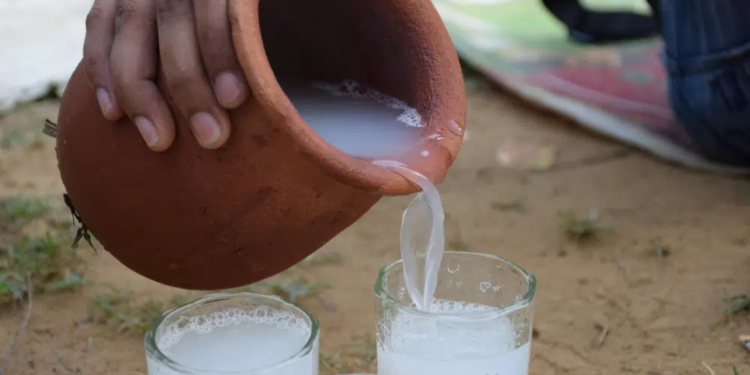Palm wine is a delightful alcoholic beverage crafted from the sap of various palm tree species. It holds a rich cultural significance in many parts of the world and can be made at home with a few simple steps. Here’s a step-by-step guide to making palm wine in the comfort of your home:
Ingredients and Equipment:
- A palm tree (varieties like Raphia palm work well)
- A container to collect the sap
- A knife or machete
- A large pot or container for fermentation
- Yeast (baking yeast or brewer yeast)
- Sugar (cane sugar or castor sugar)
Step 1: Tapping the Palm Tree
1.1. Choose a healthy palm tree with a flower spike. The flower spike is where you’ll collect the sap.
1.2. Use a knife or machete to cut a V-shaped notch into the flower spike. Make sure it’s deep enough to allow the sap to flow out. Be cautious during this step to avoid injuring yourself.
1.3. Place a container, such as a bucket or calabash, beneath the cut to collect the dripping sap. The sap will flow out naturally.

Step 2: Collecting the Sap
2.1. Allow the sap to drip into the container for several hours or overnight. The quantity collected depends on the size of your container and the palm tree’s sap flow.
2.2. Once you’ve collected enough sap, carefully remove the container beneath the palm tree.
Step 3: Fermentation
3.1. Transfer the collected sap into a large pot or container suitable for fermentation.
3.2. Add yeast to the sap. You can use baking yeast or brewer yeast. The amount of yeast depends on the quantity of sap, but a teaspoon per litre of sap is a good starting point.
3.3. If you want a sweeter palm wine, you can also add sugar at this stage. Cane sugar or castor sugar works well. Adjust the amount to your taste preferences, but a few tablespoons per litre of sap should be sufficient.
3.4. Mix the sap, yeast, and sugar thoroughly to ensure even fermentation.

Step 4: Fermentation Process
4.1. Cover the container with a lid or cloth, leaving a small opening for gas to escape. This prevents contaminants from entering while allowing carbon dioxide produced during fermentation to escape.
4.2. Place the container in a cool, dark place and let it ferment for several days. The duration of fermentation can vary, but it usually takes a few days to a week.
4.3. During fermentation, the sap will transform into palm wine. You’ll notice the liquid becoming slightly fizzy, and its alcohol content will increase.

Step 5: Enjoy Your Homemade Palm Wine
5.1. Once the palm wine has reached your desired taste and alcohol content, it’s ready to be enjoyed.
5.2. Serve your homemade palm wine chilled in a glass or calabash, and savour its unique flavour.
Note: Homemade palm wine typically has a lower alcohol content compared to commercially produced palm wine. Exercise caution when consuming it, and enjoy it in moderation.
Making palm wine at home is a rewarding process that allows you to enjoy this traditional beverage in the comfort of your own space. Remember to be mindful of local regulations and traditions related to palm wine production in your area. Enjoy responsibly!

Discussion about this post